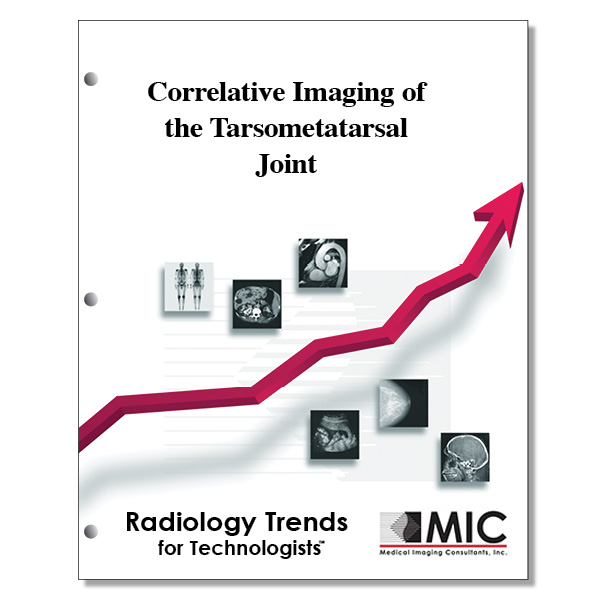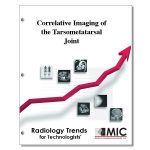

Correlative Imaging of the Tarsometatarsal Joint
The anatomy, injury mechanisms, classification systems, and imaging features of injuries to the tarsometatarsal joint are reviewed.
Course ID: Q00399 Category: Radiology Trends for Technologists Modalities: CT, MRI, Nuclear Medicine, Radiography3.5 |
Satisfaction Guarantee |
$37.00
- Targeted CE
- Outline
- Objectives
Targeted CE per ARRT’s Discipline, Category, and Subcategory classification for enrollments starting after May 25, 2023:
[Note: Discipline-specific Targeted CE credits may be less than the total Category A credits approved for this course.]
Computed Tomography: 2.25
Procedures: 2.25
Head, Spine, and Musculoskeletal: 2.25
Magnetic Resonance Imaging: 3.50
Procedures: 3.50
Musculoskeletal: 3.50
Nuclear Medicine Technology: 2.25
Procedures: 2.25
Other Imaging Procedures: 2.25
Radiography: 3.50
Procedures: 3.50
Extremity Procedures: 3.50
Registered Radiologist Assistant: 3.50
Procedures: 3.50
Musculoskeletal and Endocrine Sections: 3.50
Sonography: 2.25
Procedures: 2.25
Superficial Structures and Other Sonographic Procedures: 2.25
Outline
- Introduction
- Anatomy
- Mechanisms of Injury
- Classification Systems
- Lisfranc Fracture-Displacements
- Quen¸ and K¸ss
- Myerson
- Lisfranc Sprains: Nunley and Vertullo Classification
- Lisfranc Fracture-Displacements
- Imaging Characteristics
- Conventional Radiography
- Bone Scintigraphy
- Ultrasonography
- Computed Tomography
- MR Imaging
- Treatment
- Conclusion
Objectives
Upon completion of this course, students will:
- describe the clinical symptoms a patient may exhibit with a Lisfranc joint complex injury
- understand the role that medical imaging modalities play in assisting in the diagnosis of a Lisfranc joint complex injury
- know who the tarsometatarsal joint is named after
- describe the difference between low impact and high impact Lisfranc joint complex injuries and the most common cause of each
- know what percentage of Lisfranc joint complex injuries initially go undiagnosed
- understand which bones of the foot make up the Roman arch configuration of the Lisfranc joint
- name the articulations that make up the Lisfranc joint complex
- know the names of the ligaments that provide stability to the Lisfranc joint complex
- know which of the ligaments in the Lisfranc joint complex are the strongest and which are the weakest
- name the most prominent nerves and vascular component that make up the Lisfranc joint complex
- name both direct and indirect mechanisms of injury to the Lisfranc joint complex
- be familiar with what types of Lisfranc joint injuries affect athletes
- name the first classification system for Lisfranc joint complex fractures
- describe the Quenü and Küss classification of high-grade Lisfranc fracture-displacements
- know which of the Quenü and Küss Classification of High-Grade Lisfranc Fracture-Displacements is the most common
- describe the modifications that Hardcastle made to the Quenü and Küss classification of high-grade Lisfranc fracture-displacements
- describe the modifications that Myerson made to the Hardcastle classification of high-grade Lisfranc fracture-displacements
- know which classification system of high-grade Lisfranc fracture-displacements is the most commonly used today
- describe the Nunley-Vertullo classification of low-grade midfoot sprains
- understand the role conventional radiography plays in diagnosing Lisfranc joint complex injuries
- describe the technical nuances of performing proper foot radiography
- describe the radiographic anatomy of the foot that is best visualized on each projection
- know what percentage of subtle Lisfranc joint complex injuries will appear normal on non-weight-bearing radiographic studies
- describe the radiographic fleck sign
- explain the necessary ancillary equipment needed to safely perform weight-bearing foot radiography to better diagnose Lisfranc joint complex injuries
- know the most frequent and reliable indicator of a Lisfranc joint complex injury on radiographic studies
- define the role that bone scintigraphy plays in the diagnosis of Lisfranc joint complex injuries, as well as its benefits and limitations
- know what role diagnostic ultrasound plays in the evaluation of patients with Lisfranc joint complex injuries
- know which projections are used with diagnostic ultrasound of the Lisfranc joint complex
- describe the benefits and limitations of using CT as a medical imaging modality in the diagnosis of Lisfranc joint complex injuries
- know the role that 3D reformatted CT plays in patients presenting with Lisfranc joint complex injuries
- describe the role MR imaging plays in the diagnosis of a Lisfranc joint complex injury
- know what size field of view is used in MR imaging of the Lisfranc joint complex
- describe the types of sequences used in MR imaging of the foot for Lisfranc joint complex injuries
- know which anatomic plane the intermetatarsal ligaments are best visualized with MR imaging
- know which anatomical plane that the Lisfranc ligament is best visualized with MR imaging
- describe the most common findings on MR imaging that indicative of ligament damage to the foot
- know what non-operative treatment options are available for Lisfranc joint complex injuries
- describe what criteria the treatment of Lisfranc joint complex injuries are based upon
- know what type of Lisfranc joint complex injuries are treated surgically as well as the various procedures performed
